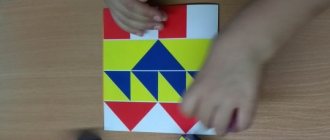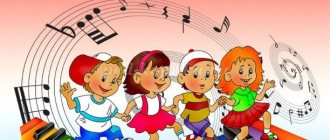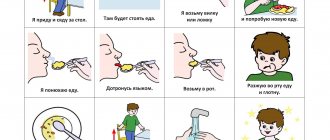Report “Subgroup form of working with children” consultation on the topic
Recently, we are increasingly faced with problems and shortcomings of frontal classes, especially in the junior and middle groups of kindergarten.
As a rule, no more than a third of all children in the group actually work in such classes - the most active children. Also in general classes, a school form of organizing children is used (like a lesson at school) with all the requirements for arbitrary behavior, which is not yet fully accessible preschoolers.
In frontal classes, it is more difficult for the teacher to take into account the individual characteristics of children, to see what a given child can cope with or not, what he can do, what needs to be worked on more.
The subgroup form of organizing children in games and in classes allows the teacher to see more clearly and more specifically the levels of mental development of each child: level 1 - the current level of preparedness, i.e. what tasks the child can complete on his own; level 2 - the “zone of proximal development” - which the child copes with with a little help from an adult. Then it is easier to achieve the main principle of didactics - the principle of developmental learning, when learning is focused not only on the achieved level, but always gets ahead of him, runs ahead of him, so that children need to make an effort to master new material.
In subgroup classes, more attention is paid to an individual approach to children. After all, in frontal classes, the teacher usually relies on children who know the material, those who raise their hands - and then the same children work actively, and the other part of the children are passive. Not having time to think looking after active children, they gradually lag behind in development and assimilation of knowledge. In individual work, the teacher can give a more complex task to a strong child, pose a difficult question to him, assign a larger amount of work; ask those who did not raise their hand, provide assistance to the weaker ones, choose individual tasks for them, ask accessible questions, let weak children feel that they are also capable of mastering the material.
Of course, subgroup classes take more time than classes with the whole group. What helps free up time is that children learn some knowledge about the world around them better and more firmly not in class, but in the course of everyday life, from communication with teachers, parents, and others children, on walks, in games.
Reading fiction is also not recommended as a separate activity. Reading takes place better in a relaxed atmosphere, when the teacher sits opposite the children, sees their eyes, how they perceive the work being read.
Subgroup English classes, when the second subgroup of children remains in the group, make it possible to free up time for educational and didactic games.
For individual lessons, the time when children arrive in kindergarten in the morning, the time in the afternoon, before the afternoon snack and after it for games, arts and crafts, and math assignments is widely used.
Subgroup work is painstaking and complex, but the results are obvious. After subgroup classes, frontal final work on any topic easily follows. More children willing to answer questions, more hands raised; children are active, noticeably liberated, their vocabulary increases stock, logical thinking and memory develop.
The positive side of subgroup work is that classes were conducted with the necessary paraphernalia - toys, pictures, illustrations, educational and didactic games were used, surprise moments were introduced - all this interested the children and made them want to study.
Forms and methods of speech therapy work in accordance with the Federal State Educational Standard for preschool education
Forms and methods of speech therapy work in accordance with the Federal State Educational Standard for preschool education
In the Federal State Educational Standard for Preschool Education, one of the psychological and pedagogical conditions for the successful implementation of the program is the use in the educational process of forms and methods of working with children that correspond to their psychological, age and individual characteristics.
The main form of correctional education in a specialized kindergarten is speech therapy classes, in which the development of all components of speech and preparation for school is systematically carried out. The program for raising and training children with speech impairments involves solving correctional problems in the form of:
frontal (subgroup) classes;
individual lessons;
classes in mobile micro groups.
Classes are conducted by a speech therapist after the children in the group are examined at the beginning of the year.
Frontal (subgroup) speech therapy classes
allow you to effectively solve those problems of speech development and correction of its deficiencies that are a priority for all or most of the group’s pupils. This type of activity develops their ability to get into the general pace of work, follow general instructions, and focus on the best speech patterns.
Thematic and concentric approaches are the basis for planning classes with children with special needs.
Thematic approach
organizing the cognitive and speech material of a lesson involves focusing it on any topic from the objective world surrounding the child. This allows for a close relationship in the work of the entire teaching staff of the group. The topic is studied in parallel in classes of different types of activities: when familiarizing yourself with the environment, developing speech, in drawing, modeling, appliqué classes, and in games. The selection and arrangement of topics are determined by the following conditions: seasonality, social significance, neutral character.
One of the most important factors in the implementation of the thematic principle is the concentrated study of the topic, which ensures repeated repetition of the same speech content in a short period of time. Repeated repetition is very important both for children’s perception of speech (passive) and for its activation.
According to the concentric approach
program content within the same topics deepens and expands from year to year.
When planning and conducting frontal subgroup speech therapy sessions:
the topic and goals of the lesson are determined;
a subject and verb dictionary, a dictionary of signs that children must learn in active speech are highlighted;
lexical material is selected taking into account the topic and purpose of the lesson, the stage of remedial education, an individual approach to the speech and mental capabilities of children, while non-normative phonetic formatting of part of the speech material is allowed;
a gradual complication of speech and speech-thinking tasks is ensured;
when selecting program material, the zone of proximal development of preschool children and potential opportunities for the development of mental activity are taken into account;
Regular repetition of learned speech material is included in classes.
Optimization
The content of the classes is ensured by their integrated nature, when different lines of work are implemented in parallel and organically complement each other to correct certain components of the speech system of preschool children, as well as deficiently developed mental and psychophysiological functions. For example, in classes on the formation of the phonetic - phonemic side of speech with the older group, when studying sound, we work on the clear pronunciation of this sound, at the same time we work on the development of phonemic hearing and the formation of phonemic perception, and we begin the formation of language analysis and synthesis when children work with symbols of sounds, trying to “read” them together.
Reliance on the game
as the leading activity of preschoolers and the mandatory inclusion of various types of games in speech therapy classes provide a pronounced positive effect both in overcoming speech disorders and in the development of cognitive mental processes.
Based on all that has been said, the following requirements
:
1. The lesson should be dynamic.
2. Game fragments and surprise moments must be included. You can include funny situations in which children will be participants.
3. There should be a frequent change of different activities.
4. It is necessary to develop a communicative orientation in children, teach them to communicate with the teacher and with each other.
5. During classes, it is necessary to teach children to listen, hear, and correct mistakes in other people’s speech and in their own.
6. Use a variety of teaching materials, colorful and convenient.
7. The most important thing is that children should talk a lot during classes.
The technologies used in the classroom should be arranged in order of increasing complexity and be varied.
Frontal classes, depending on specific tasks and stages of speech correction, are divided into the following types
:
1. Classes on the formation of the phonetic-phonemic side of speech.
2. Classes on the formation and development of coherent speech.
3. Lexical lessons with elements of grammar.
4. Classes on the formation of lexical and grammatical categories.
The main objectives of classes on the formation of phonetic-phonemic
aspects of speech are: the development of phonemic hearing and the formation of phonemic perception, skills of pronouncing words of different sound-syllable structure; control over the intelligibility and expressiveness of speech; preparation for mastering basic skills of sound analysis and synthesis.
The specificity of this type of lesson determines the selection of lexical material rich in studied and correctly pronounced sounds.
The goal of classes on the formation and development of coherent speech
is teaching children to express themselves independently. Based on the developed skills of using various types of sentences, children develop the ability to convey impressions of what they saw, about the events of the surrounding reality, to present the contents of pictures or their series in a logical sequence, to compose a story - a description.
At a lexical lesson with elements of grammar
a “lexical” approach is used. With this approach, children’s knowledge and information and their vocabulary are replenished. The speech therapist selects games that can be used to reinforce some grammatical form that is already present in the children’s speech.
During classes on the formation of lexical and grammatical categories
a lexical-grammatical approach is used. With this approach, the most typical forms of word formation are studied in the classroom, as well as the basic models of constructing phrases and sentences characteristic of the grammatical system of the Russian language. Thus, preschoolers with general speech underdevelopment develop grammatical concepts. The main objectives of these classes are the development of understanding of speech, clarification and expansion of vocabulary, the formation of general concepts, the formation of practical skills in word formation and inflection, the ability to use simple common sentences and some types of complex syntactic structures.
In our kindergarten, in the second junior and middle groups, lexical lessons with elements of grammar are held. In the senior and preparatory groups, classes are held on the formation of lexical and grammatical categories.
Why are different types of activities
? In the younger groups in the speech therapy kindergarten, the main emphasis in the speech therapist’s work is on enriching the children’s vocabulary. And here we need lexical classes. Those. in accordance with the thematic annual planning, a lexical topic is selected, the attention of the speech therapist and children in the lesson is completely focused on the dictionary, lexical and grammatical categories, if taken, are only those already known to the child. In this type of lesson, the study of lexical and grammatical categories plays a secondary role.
In older groups, the study of lexical and grammatical categories takes 1st place, that is, in one lesson, the speech therapist plans to study only one lexical and grammatical topic. This is due to the fact that not a single grammatical category can enter the independent speech of speech-language pathologists without repeated conscious use of it in different phrases and sentences. Topics for lexical and grammatical lessons are not chosen randomly, but in accordance with the physiological and psychological and pedagogical characteristics of the formation of a child with OPD.
Classes in mobile microgroups
provide the speech therapist with the opportunity to vary their goals and content depending on the tasks of correctional work, speech and individual typological characteristics of the pupils. At the beginning of the year, when more time is allocated to producing sounds, children who have more or less homogeneous defects in the pronunciation of sounds are usually grouped together. Later, when the emphasis moves to consolidating the given sounds, the opportunity to include exercises aimed at expanding the vocabulary and mastering grammatically correct speech increases; it is advisable to regroup the children taking into account the entire volume of speech work. This approach helps differentiated work with children whose deficiencies are expressed mainly in the sound aspect of speech. Also during classes in mobile microgroups, lexical and grammatical categories are consolidated, work on the development of phonemic hearing and the formation of phonemic perception.
Individual sessions
constitute a significant part of the speech therapist’s working time each day. They allow for the correction of speech and other deficiencies in psychophysical development, which are deeply individual for each student.
The role of such activities is especially great in working with children of primary and secondary preschool age, whose characteristics make it difficult to establish productive contacts with adults, and even more so with peers. Nevertheless, a gradual move away from individual lessons to lessons in small subgroups during the school year makes it possible to optimize time expenditure and move on to the formation of some skills in the joint productive and speech activity of children.
There are certain requirements for individual speech therapy sessions .
When preparing and conducting them, the speech therapist must:
formulate the topic and goals of the lesson;
think through the stages of the lesson, their connection with each other;
plan a gradual complication of the speech material of the lesson;
carry out a differential approach to each child, taking into account the structure of the speech defect, age and individual characteristics;
formulate instructions briefly and clearly;
use varied and colorful visual material;
be able to create a positive emotional background in the lesson.
The main task of individual lessons is the initial formation of the sound side of speech, which includes a set of preparatory articulation exercises, correction of the pronunciation of defective sounds, the syllabic structure of the word, the development of phonemic hearing and the formation of phonemic perception.
When determining the content of an individual speech therapy lesson, selecting speech and practical material, the speech therapist should strive to make the lesson not only interesting, but also as productive as possible, with high speech activity of the child. To do this, you can select lexical and grammatical games and games for the development of the higher mental function with words rich in automated sound.
Individual lessons usually include the following stages: firstly, articulation gymnastics, then finger gymnastics, then work on staging or automating sound. Lexical material should contain the maximum number of fixed sounds. It is necessary to increase the pace of speech exercises from leisurely, exaggerated pronunciation to faster pronunciation and, finally, to tongue twisters. The requirement here is for a gradual complication of lexical material, a transition from simple types of speech activity to more complex ones - from elementary repetition of words with a speech therapist, to naming objects, descriptions, poems, retellings, compiling stories from pictures.
– health-saving technologies
. Health-saving technologies are very important for our children with disabilities, because... These are usually children with poor health. The selection of elements of various health-saving technologies depends on the age and psychophysiological characteristics of children.
Health-saving technologies include visual gymnastics, changing static and dynamic poses, voice and breathing exercises, outdoor games of a speech nature, exercises for the correction of general and fine motor skills. Gradually incorporating various types of massage, dynamic pauses, finger games, and eye exercises into each lesson, the speech therapist creates the necessary atmosphere that reduces tension and allows you to use the entire lesson time more effectively. All exercises should be performed against the backdrop of positive responses from the child.
Speech therapy intervention is carried out using various methods, among which visual, verbal and practical ones are conventionally distinguished.
Visual methods are aimed at enriching the content of speech, verbal methods are aimed at teaching retelling, conversation, storytelling without relying on visual materials. Practical ones are used in the formation of speech skills through the widespread use of special exercises and games. Practical methods include the recently widely used modeling methods and the project method.
The modeling method is one of the promising areas for improving the process of correctional and developmental education and is actively used in our kindergarten. The use of substitutes and visual models develops children's mental abilities. A child who masters forms of visual modeling has the opportunity to use substitutes and visual models in his mind, use them to imagine what adults are talking about, and foresee the possible results of his own actions. The introduction of visual models allows for more targeted reinforcement of skills in the process of remedial training. For example, when preparing to teach literacy, the visual modeling method allows you to solve the following problems:
— Introduce children to the concept of “word” and its extent;
- teach how to distinguish sounds in a word intonationally, find the position of sounds in a word and correlate them with a diagram, depict vowel and consonant sounds using visual symbols;
- develop skills in analyzing and synthesizing words and sentences.
When teaching coherent speech, modeling can be used to work on all types of coherent utterances. At this stage, the visual modeling method contributes to:
- mastering the principle of substitution (the ability to designate characters in a work of art as substitutes), conveying events with the help of substitutes;
- mastering the ability to identify fragments of a picture that are significant for the development of the plot, determine the relationship between them and combine them into one plot;
- developing the ability to create a special idea and develop it into a complete story;
The use of visual models in working on the monologue speech of children with special needs allows us to more successfully teach children how to compose a coherent speech utterance.
Thus, the results of the ongoing correctional training indicate the wide possibilities of using visual modeling in speech therapy work with children of senior preschool age who have general speech underdevelopment.
Recently, the project method has been actively used in our garden. The use of this method is a fundamentally different approach to building the educational process, based on the active research position of children, taking into account their personal interests. This is a way to achieve a goal through a detailed development of a problem, the result of which is a product designed in one way or another. This year, the preparatory group developed and then presented a project on the topic: “Motives of Autumn.” This project develops the emotional sphere and musical and aesthetic feelings of older preschoolers with speech disorders. By exploring the world around us, the child gains generalized experience in the development of speech, cognitive, musical and aesthetic abilities.
In order for children to show musical and aesthetic feelings, it is necessary to instill in them a love of good music and teach them to understand this music, and this is impossible without the development of musical abilities.
The activities of teachers in this project were focused on introducing children to a highly artistic and accessible musical repertoire, and on developing the creative activity of children.
Another innovation in the work of our kindergarten is the use of such a method of correcting speech disorders in children as logostories. We are just beginning to develop this project, the goal of which is to create conditions for early propaedeutics of speech disorders in children through play activities. With the help of logostories, we hope to solve the following problems of speech therapy correction of the communicative sphere of children:
— creation of a favorable psychological atmosphere during educational activities;
- enrichment of the emotional and sensory sphere of children through communication with a fairy tale;
- development of dialogic and monologue speech;
- increasing the effectiveness of play motivation of children's speech, its artistic and aesthetic orientation;
- introducing children to the beauty of artistic expression and folklore;
— development of cooperation between teachers, speech therapists and educators with children and with each other based on a personality-oriented model of interaction.





